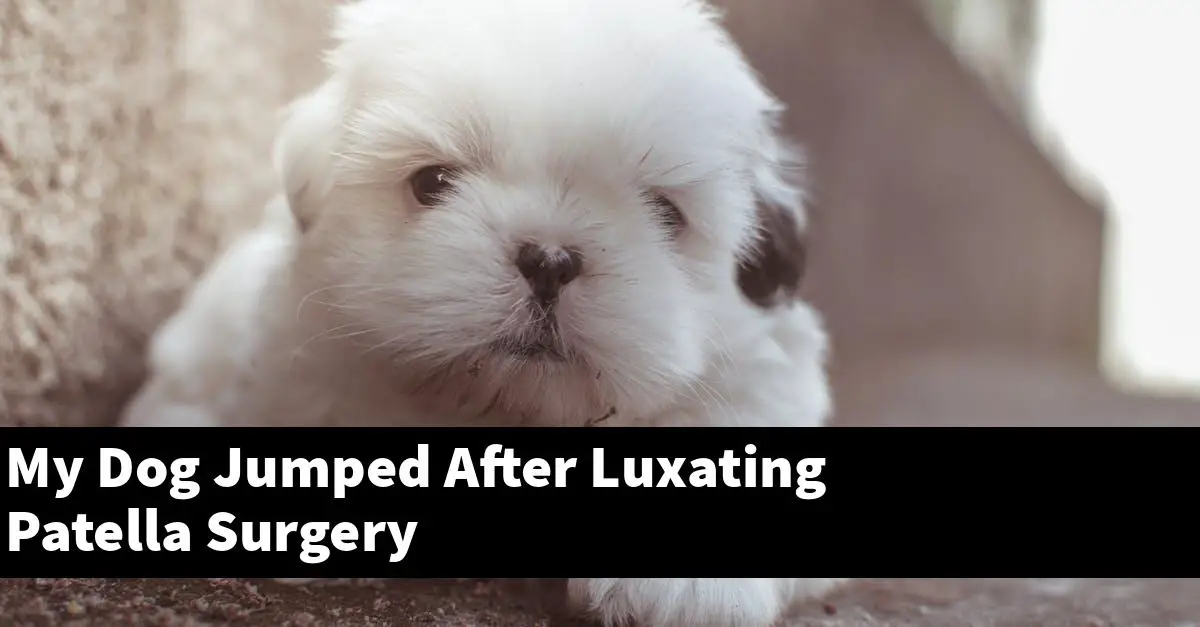A luxating patella is a condition in which the kneecap (patella) slips out of its normal location. This can occur in both dogs and cats. Surgery is often needed to correct the problem. In most cases, the prognosis is good following surgery.
The article will be discussing how the surgery affected the dog and whether or not it was successful.
Table of Contents
How long after luxating patella surgery should I keep my dog from jumping?
After a luxating patella surgery, it is important to keep your dog from jumping for at least six weeks. This will allow the incision to heal properly and will help to prevent the patella from Luxating again.
What are the risks of my dog re-injuring their luxating patella?
The risks of a dog re-injuring their luxating patella are significant. If the injury is not properly treated, the chances of the knee joint becoming permanently damaged are high. Without treatment, the dog may also experience pain and lameness.
How can I help my dog heal properly after surgery?
After your dog has surgery, there are some things you can do at home to help them heal properly. First, keep them quiet and calm. This means no running, playing, or jumping. Too much activity can cause bleeding or other complications.
Second, keep the area clean and dry. This means cleaning any stitches or incisions with soap and water. You may also need to put on a clean dressing.
Third, give your dog the prescribed medication. This will help with pain and infection.
Fourth, watch for any signs of infection, such as redness, swelling, or discharge from the incision. If you see any of these signs, call your veterinarian right away.
Finally, follow your veterinarian’s instructions for follow-up care. This may include bringing your dog in for check-ups or bandage changes.
By following these instructions, you can help your dog heal properly after surgery.
What are some warning signs that my dog’s patella may be luxating again?
One of the most common signs that a dog’s patella may be luxating again is when they begin to skip or hop while they walk. This is caused by the patella becoming dislocated and not tracking properly in the knee joint. Other signs include:
-Limping or holding the leg up
-Unwillingness to put weight on the leg
-Swelling or pain in the knee area
-Difficulty straightening the leg
If you notice any of these signs, it’s important to take your dog to the vet to have them checked out. The vet will likely recommend x-rays to confirm the diagnosis and may recommend surgery to fix the problem.
How do I stop my dog from jumping on the couch after surgery?
If your dog has just undergone surgery, it is important to keep them calm and relaxed to help them heal properly. One way to do this is to keep them off of the couch. Dogs are naturally active and may want to jump on the couch to play or just to rest, but this can put unnecessary strain on their healing body.
There are a few things you can do to keep your dog off the couch. First, make sure the couch is not easily accessible. Move it away from any doorways or stairs that your dog can use to get on it. You may also want to put a gate up in front of the couch or block off the area with furniture.
If your dog is still trying to jump on the couch, you can provide them with an alternative place to rest. A dog bed on the floor next to the couch may entice them to lay down and stay off of the furniture. You can also try using positive reinforcement to train your dog to stay off of the couch. Give them treats or praise when they stay off of it and avoid giving them attention when they jump on it. With a little patience and training, your dog will learn to stay off of the couch and heal properly.
How do I stop my dog jumping up after knee surgery?
If your dog has recently undergone knee surgery, it is important to take measures to prevent them from jumping up and injuring themselves. There are a few things you can do to help stop your dog from jumping up:
– Keep them on a leash when they are outside or in areas where they may be tempted to jump.
– Use a crate or baby gate to confine them to a safe area when you can’t be supervising them.
– Keep them occupied with toys or bones so they don’t have the urge to jump up.
– Reward them with treats or praise when they refrain from jumping.
If you follow these tips, you can help your dog heal properly and avoid any further injury.
How long after knee surgery can a dog jump?
How long after knee surgery can a dog jump?
It is generally recommended that dogs refrain from jumping for at least two weeks after knee surgery. This allows the incisions to heal and the knee to stabilize. Some dogs may be able to jump sooner depending on the extent of their surgery. However, it is always best to check with your veterinarian before allowing your dog to jump.
What happens if a dog runs after TPLO surgery?
TPLO surgery, or Tibial Plateau Leveling Osteotomy, is a type of orthopedic surgery often performed on dogs. The surgery is used to correct a condition known as cranial cruciate ligament disease, or CCLD. CCLD is a common problem in dogs, and can cause pain, lameness, and arthritis. TPLO surgery is a procedure that involves cutting the bone and realigning it to reduce the stress on the ligament. This can provide relief from pain and help to prevent further damage to the joint.
After TPLO surgery, it is important to keep your dog calm and quiet. This means no running, jumping, or playing. Walking is fine, but your dog should not be exerting themselves. If your dog does run or jump after surgery, it can put undo stress on the joint and cause pain or damage. It is important to follow your veterinarian’s instructions and keep your dog calm and quiet for at least two weeks after surgery. After that, you can slowly start to increase their activity level as your veterinarian advises.
Summary
– Dogs should not jump or run for at least two weeks after TPLO surgery. This helps to prevent pain and further damage to the joint.


